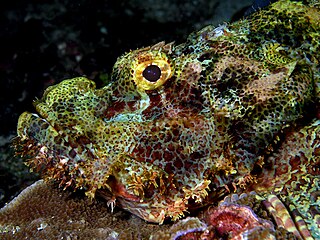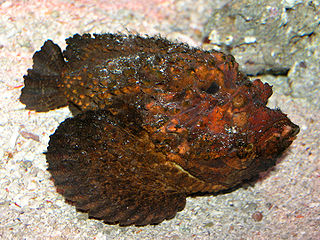
The Scorpaenidae are a family of mostly marine fish that includes many of the world's most venomous species. As their name suggests, scorpionfish have a type of "sting" in the form of sharp spines coated with venomous mucus. The family is a large one, with hundreds of members. They are widespread in tropical and temperate seas but mostly found in the Indo-Pacific. They should not be confused with the cabezones, of the genus Scorpaenichthys, which belong to a separate, though related, family, Cottidae.

Synanceia verrucosa, the reef stonefish or simply stonefish, is a species of venomous, marine ray-finned fish, belonging to the subfamily Synanceiinae which is classified as being within the family Scorpaenidae, the scorpionfishes and their relatives. It is the most widespread species of stonefish, mostly found in shallow waters of the Red Sea and the Indo-Pacific. It is the deadliest fish in the sea, with highly effective venom which can be lethal to humans.

Synanceiinae is a subfamily of venomous ray-finned fishes, waspfishes, which is classified as part of the family Scorpaenidae, the scorpionfishes and their relatives. These fishes are found in the Indo-Pacific oceans. They are primarily marine, though some species are known to live in fresh or brackish waters. The various species of this family are known informally as stonefish, stinger, stingfish and ghouls. Its species are known to have the most potent neurotoxins of all the fish venoms, secreted from glands at the base of their needle-like dorsal fin spines. The vernacular name, stonefish, for some of these fishes derives from their behaviour of camouflaging as rocks. The type species of the family is the estuarine stonefish.

Scorpaena cardinalis, the eastern red scorpionfish, grandfather hapuku, cardinal scorpionfish, Cook's scorpionfish, Cook's rockcod, Kermadec scorpionfish, Northern scorpionfish, red scorpion fish, red scorpion-cod or Sandy-bay cod, is a species of marine ray-finned fish belonging to the family Scorpaenidae, the scorpionfishes. It is found in the southwestern Pacific Ocean.

Little velvetfishes or simply velvetfishes are a family, the Aploactinidae, of marine ray-finned fishes classified within the order Scorpaeniformes. They are small fish that have skin with a velvet texture. They live on the sea bottom close to the shore, at depths of up to 100 metres (330 ft). They are found in the Indo-Pacific region.

Apistinae, the wasp scorpionfishes, is a subfamily of venomous, marine ray-finned fishes belonging to the family Scorpaenidae, the scorpionfishes and related species. These fishes are native to the Indian Ocean and the western Pacific Ocean.

Scorpaena is a widespread genus of marine ray-finned fish belonging to the family Scorpaenidae, the scorpionfishes.

Synanceia is a genus of ray-finned fish belonging to the subfamily Synanceiinae, the stonefishes, which is classified within the family Scorpaenidae, the scorpionfishes and relatives. Stonefishes are the most venomous fish known; stings can be fatal to humans. They are found in the coastal regions of the Indo-Pacific.

Synanceia horrida, the estuarine stonefish, hollow-cheek stonefish, horrid stonefish, rough stonefish or true stonefish, is a species of venomous, marine ray-finned fish, a stonefish belonging to the subfamily Synanceiinae which is classified as being within the family Scorpaenidae, the scorpionfishes and their relatives. It is a benthic fish which is found in the Indo-Pacific region. This species is considered to be one of the most dangerous venomous fish in the world. It is a popular exhibit in public aquaria and is found in the private aquarium trade.

Scorpaena scrofa, the red scorpionfish, bigscale scorpionfish, large-scaled scorpion fish, or rascasse is a venomous marine species of ray-finned fish in the family Scorpaenidae, the scorpionfishes. It is found in the Mediterranean Sea, in the eastern Atlantic Ocean and the western Indian Ocean.

Small red scorpionfish is a venomous Scorpionfish, common in marine subtropical waters. It is widespread in the Eastern Atlantic from the Bay of Biscay to Senegal, Madeira, Azores and the Canary Islands, including the Mediterranean and the Black Sea.

The western scorpionfish, also known as the neglected scorpionfish, is a species of marine ray-finned fish belonging to the family Scorpaenidae, the scorpionfishes. It is found in the western Pacific Ocean.
Scorpaena cocosensis, the Cocos scorpionfish, is a species of marine ray-finned fish belonging to the family Scorpaenidae, the scorpionfishes. It is found in the eastern Pacific Ocean.

The pitted stonefish, also known as the Pacific monkey-fish, is a species of venomous ray-finned fish, a stonefish be longing to the subfamily Synanceiinae of the family Scorpaenidae, the scorpionfishes and their relatives. It is the only species in the monotypic genus Erosa and is found in the eastern Indian Ocean and the western Pacific Ocean.
Leptosynanceia is a monotypic genus of ray-finned fish belonging to the subfamily Synanceiinae, the stonefishes, which is classified within the family Scorpaenidae, the scorpionfishes and relatives, its only species is Leptosynanceia asteroblepa which is called the mangrove stonefish in Malaysia. This species native to the brackish and fresh waters of Southeast Asia. This species grows to a total length of 23 centimetres (9.1 in). This species is an extremely dangerous fish whose venom can cause a human to die within 1 to 2 hours after contact. The pain caused by the venom is described as "agonizing".

Minous, is a genus of marine ray-finned fishes, it is the only genus in the tribe Minoini, one of the three tribes which are classified within the subfamily Synanceiinae within the family Scorpaenidae, the scorpionfishes and their relatives. They are commonly known as stingfishes. They are found in the Indo-West Pacific.

The blackfin stonefish is a species of venomous ray-finned fish, a stonefish be longing to the subfamily Synanceiinae of the family Scorpaenidae, the scorpionfishes and their relatives. It is the only species in the monotypic genus. It is native to the western Indian Ocean where it occurs in areas with muddy bottoms. This species grows to a total length of 13 centimetres (5.1 in).

The stargazing stonefish is a species of stonefish native to the Indian Ocean and the western Pacific Ocean where it is found on muddy bottoms in estuaries. This venomous species is also a minor component of local commercial fisheries. This species grows to a length of 8 centimetres (3.1 in) SL. This species is the only known member of the genus Trachicephalus.

Scorpaenopsis diabolus, the false stonefish, false scorpionfish or the devil scorpionfish, is a species of venomous marine ray-finned fish belonging to the family Scorpaenidae, the scorpionfishes. It has venomous spines and lives in the tropical Indian and Pacific Oceans as well as in the Red Sea. It is a bottom-dwelling predator that relies on its camouflage to catch passing prey.

Minous monodactylus, the grey stingfish or grey goblinfish, is a species of marine ray-finned fishes, it is the only genus in the tribe Minoini, one of the three tribes which are classified within the subfamily Synanceiinae within the family Scorpaenidae, the scorpionfishes and their relatives. This species found in the Indo-Pacific and is venomous to humans.


















